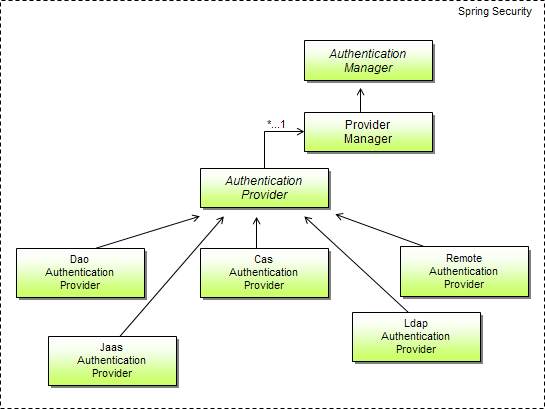Spring Security
Spring Security, historically also known as Acegi Security, provides a comprehensive security solution for handling authentication and authorization. Spring Security namespace provides directives for most common operations, allowing complete security configuration in just a few lines of XML.
Spring Security comes with authentication providers for many occasions. Most common are the DaoAuthenticationProvider for retrieving user information from a database; LdapAuthenticationProvider for authentication against a Lightweight Directory Access Protocol (LDAP![]() Lightweight Directory Access Protocol.
An open, vendor-neutral, industry standard application protocol for accessing and maintaining distributed directory information services over an Internet Protocol (IP) network.) server;
Lightweight Directory Access Protocol.
An open, vendor-neutral, industry standard application protocol for accessing and maintaining distributed directory information services over an Internet Protocol (IP) network.) server; JaasAuthenticationProvider for retrieving user information from a JAAS login configuration; etc.
You must apply Password Encoding. See Default File-Based Security for details on defining a password encoder.
For more information, please refer to the Spring Security website.
Authenticating Users
In Spring Security, the authentication manager assumes the job of establishing a user's identity. An authentication manager is defined by the org.springframework.security.authentication.AuthenticationManager interface. The authenticate method will attempt to authenticate the user using the org.springframework.security.core.Authentication object (which carries the principal and credentials). If successful, the authenticate method returns a complete Authentication object, including information about the user's granted authorities. If authentication fails, an authentication exception will be thrown.
The AuthenticationManager interface is quite simple and you could easily implement your own AuthenticationManager. But Spring Security comes with org.springframework.security.authentication.ProviderManager, an implementation of AuthenticationManager that is suitable for most situations.
Configuring a Provider Manager
ProviderManager is an authentication manager implementation that delegates responsibility for authentication to one or more authentication providers, as shown in the figure below.
The purpose of ProviderManager is to enable you to authenticate users against multiple identity management sources. Rather than relying on itself to perform authentication, ProviderManager steps one by one through a collection of authentication providers, until one of them successfully authenticates the user (or until it runs out of providers). This makes it possible for Spring Security to support multiple mechanisms for a single request.

The following chunk of XML shows a typical configuration of ProviderManager in the Spring configuration file:
<sec:authentication-manager>
<sec:authentication-provider ref="daoAuthenticationProvider"/>
<sec:authentication-provider ref="anonymousAuthenticationProvider"/>
<sec:authentication-provider ref="ldapAuthenticationProvider"/>
</sec:authentication-manager>ProviderManager is given a list of authentication providers through its providers property. Typically, you'll only need one authentication provider, but in some cases, it may be useful to supply a list of several providers so that if authentication fails against one provider, another provider will be tried.
Spring comes with numerous authentication providers. We will concentrate on a couple of the most commonly used authentication providers, to give an example how GigaSpaces authorities are to be managed. If you can't find an authentication provider that suits your security needs, you can always create your own by implementing the org.springframework.security.authentication.AuthenticationProvider interface.
 In-Memory Data Grid - achieve unparalleled speed, persistence, and accuracy.
In-Memory Data Grid - achieve unparalleled speed, persistence, and accuracy.